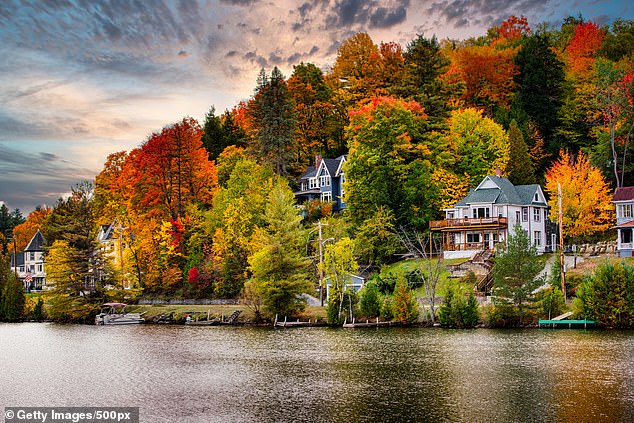Ten o’clock on a blisteringly hot morning in New York’s Moynihan Train Hall, and platform seven is buzzing with excitement. The silver Amtrak train – like an elongated Airstream – is purring quietly on the tracks, while travellers heave rucksacks and suitcases up the steps and into the carriages.
After a summer closed for track renovations, America’s daily cross-border train between New York and Montreal is up and running again; a 12-hour journey through the picturesque Hudson River valley and the foothills of the Adirondacks.
Unlike most of my fellow travellers, I’m jumping off at Albany to spend a few days exploring upstate New York, before re-boarding at Plattsburgh to head on to Canada. The towns and villages that populate the Hudson River valley are popular with New York weekenders, but I’m heading further to explore the Adirondacks. My first stop is Lake George – known as the Queen of the Lakes – which, when there are more than 3,000 in the region, is quite an accolade. Stretching for over 50km, its banks are dotted with small resorts and palatial mansions, dating back to when the lake was a summer playground for millionaire industrialists of the Gilded Age.

Leafy splendour: Annabelle Thorpe takes a ride on the Amtrak train between New York and Montreal. Along the way, she passes Lake Placid in the Adirondacks (pictured)
With a short time to explore, I book a ticket on the Minnie Ha-Ha, a traditional paddle steamer with a piercing whistle announcing our departure to everyone within ten miles. As we drift past a resort with rows of empty sunbeds, the captain gets on the tannoy: ‘They like a lie-in over there,’ he says, as he fires up the steam whistle. ‘How about we wake ’em up?’
Back on dry land, it’s on up to Gore Mountain, where gondolas carry mountain bikers and hikers in summer and skiers in winter up to the top station at over 3,000ft. As the cabin glides upwards, I’m reminded that American scenery is on a different scale to ours; vast forested mountains ripple out around aquamarine lakes.
It’s a feeling that grows as I go further north, through great swathes of forest to the town of Lake Placid, famous for hosting the Winter Olympics in 1932 and 1980. Main Street, picturesque with cafes, hotels and shops, fronts onto Mirror Lake, offering kayaking, paddleboarding and the chance to swim.

Annabelle stops in Lake George (seen above). ‘Stretching for over 50km, its banks are dotted with small resorts and palatial mansions, dating back to when the lake was a summer playground for millionaire industrialists of the Gilded Age,’ she writes

The Amtrak train (pictured) was closed over summer for track renovations but is now back up and running, reveals Annabelle
Shop windows are full of hunting and fishing gear. But it’s the Olympic legacy that defines the town, from the two ski jumps that tower over it, to the gleaming Olympic Centre housing the newly-revamped museum. The interactive exhibits give a (virtual) chance to experience the thrill of a bobsleigh run or a ski jump at white-knuckle speeds. At the actual ski jump park the lift takes visitors up to the 120-metre high platform from where the skiers push off.
Next day I stroll along the waterfront at Saranac Lake – famous for its art galleries – and visit High Falls Gorge, where four waterfalls converge and cascade over the rocks. The viewing platforms offer the chance to get up close to the hurtling water – and get more than a little damp.
After four days’ exploring, I drive back to Plattsburgh to reboard the train. Dusk is falling as we chug slowly towards Canada, pausing for a two-hour stop at the border, where the police check everyone’s passport. An hour later, Montreal’s imposing skyline comes into view, and illuminated towers twinkle in the gloom. At the city’s Gare Centrale, I feel as if I’ve stepped through the looking glass; everyone is suddenly speaking French.

Annabelle takes a stroll along Lake Saranac, which is famous for its art galleries

Arriving in Montreal (pictured), Annabelle admires its ‘twinkling’ panorama
Next morning, Daniel, a local guide, walks me through the Mile End district via some famous foodie stops, from the legendary Fairmount Bagels (12,000 baked a day) to La Cornetteria for ricotta-filled cannelloni and the Jean-Talon market, home to local specialist producers and farm stalls.
It’s a delicious introduction to Canada’s multicultural city, with French and English interchangeable alongside Italian, Portuguese and a host of other languages.
On my last day, I take the metro to Old Montreal, where the buildings look like they’ve been plucked from rural France – a legacy of the city’s colonial past. Shops selling Inuit sculpture and paintings of snowy landscapes make me wish this was just another stop on my journey. Instead, the flight home beckons – 400 miles and a wilderness away from where it began.

